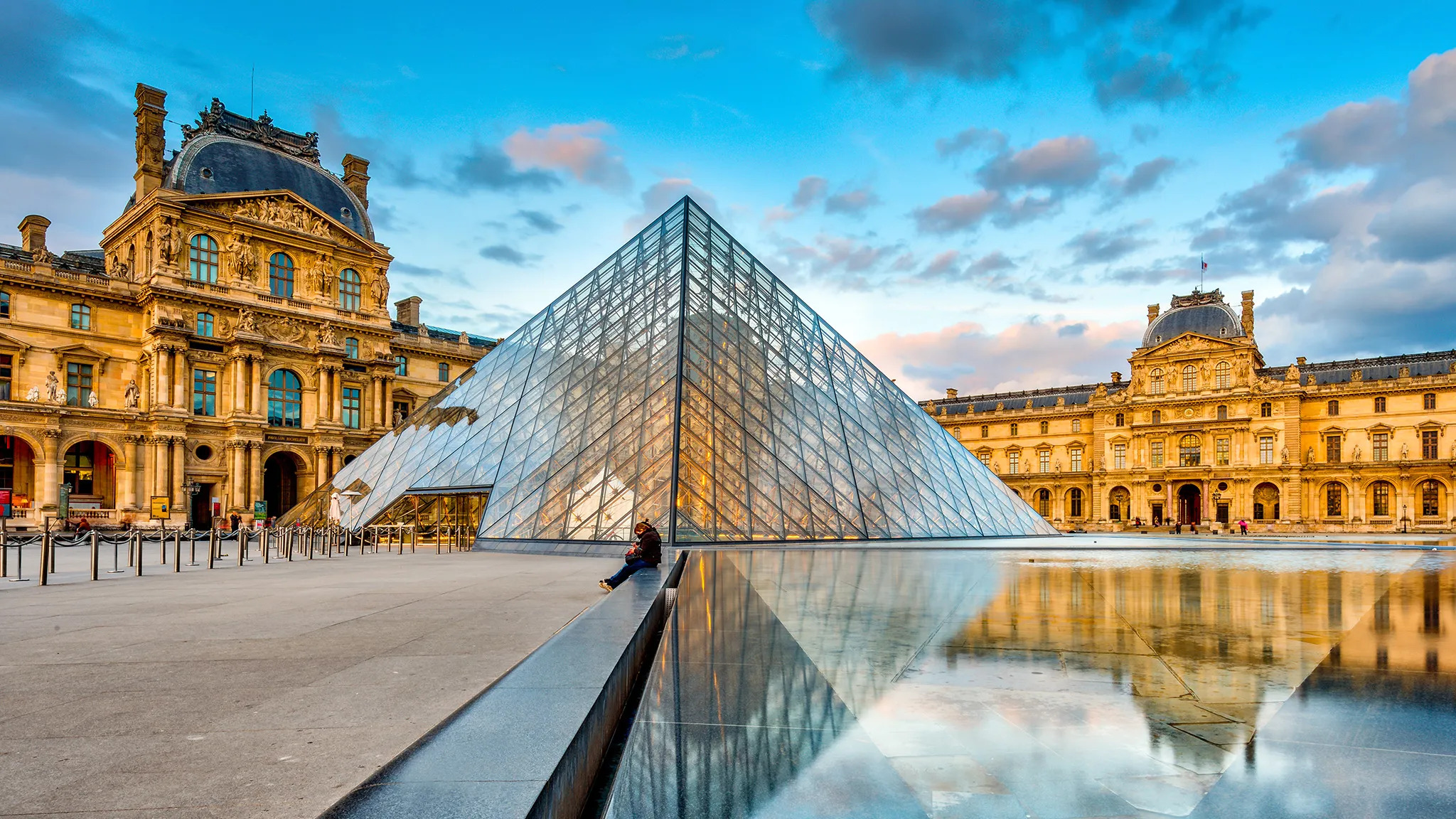
The Louvre Museum, located in Paris, France, is one of the world’s most famous and visited museums. It is home to over 35,000 works of art, spanning from ancient civilizations to the 21st century. Here are 25 interesting facts about the Louvre:
1. The Louvre was originally a fortress built in the late 12th century to protect the city of Paris from Viking invasions. It was later converted into a royal palace and, eventually, a museum.
2. The Louvre’s most famous work of art is the Mona Lisa, also known as the “La Gioconda” in Italian. It was painted by Leonardo da Vinci in the early 16th century and is considered a masterpiece of Renaissance art.
3. The Louvre is so large that it would take over 100 days to see every work of art on display if you spent just one minute looking at each piece.
4. The Louvre is home to over 35,000 works of art, but only about 3500 are on display at any given time. The rest are kept in storage or loaned out to other museums around the world.
5. The Louvre is not just a museum of art. It also has a large collection of ancient artifacts, including Egyptian mummies and the remains of a woolly mammoth.
6. The Louvre was the first museum to be opened to the public in Europe. It began allowing visitors in 1793, during the French Revolution.
7. The Louvre has undergone several major renovations and expansions over the years, including a major overhaul in the 1980s that added the famous glass pyramid in the museum’s courtyard.
8. The Louvre is the most visited museum in the world, with over 10 million visitors each year. It is also the world’s largest museum, with over 60,600 square meters of exhibition space.
9. The Louvre’s collection is so vast that it is divided into eight different departments, including Egyptian Antiquities, Greek, Etruscan, and Roman Antiquities, and Islamic Art.
10. The Louvre is not just a museum, it is also a research center and a center for cultural exchange. It offers educational programs and events for visitors, and hosts exhibitions and conferences on a wide range of topics.
11. The Louvre’s collection of art is so extensive that it has works from almost every major period in the history of Western art. This includes ancient Greek and Roman sculptures, medieval tapestries, Renaissance paintings, and modern works by artists like Pablo Picasso and Vincent van Gogh.
12. In addition to the Mona Lisa, the Louvre is home to other iconic works of art, including the Winged Victory of Samothrace, the Venus de Milo, and the Coronation of Napoleon.
13. The Louvre has been the subject of several novels, movies, and TV shows, including Dan Brown’s best-selling novel “The Da Vinci Code” and the hit film adaptation starring Tom Hanks.
14. The Louvre is not just a tourist attraction, it is also a popular spot for locals. Many Parisians visit the museum regularly to see new exhibitions or to enjoy the peaceful atmosphere of the galleries.
15. The Louvre is not only a museum of art, it is also a symbol of French culture and history. It is one of the most recognizable landmarks in Paris, and a must-see destination for anyone visiting the city.
16. The Louvre is not only a museum, it is also a cultural center that hosts a variety of events and exhibitions throughout the year. These include concerts, workshops, lectures, and special exhibitions on a wide range of topics.
17. The Louvre is not just a place to see art, it is also a place to learn about art. The museum offers a variety of educational programs and resources for visitors, including guided tours, audio guides, and multimedia displays.
18. The Louvre is not only a museum, it is also a research center that is dedicated to the study of art and cultural history. The museum’s curators and researchers work to preserve and document the works in its collection, and to provide new insights into their significance.
19. The Louvre is not only a museum, it is also a place that is constantly evolving. The museum regularly acquires new works of art, and organizes exhibitions that highlight different aspects of its collection. This means that there is always something new to see and discover at the Louvre.
20. The Louvre is not just a museum, it is a cultural institution that is deeply intertwined with the history of France. Its collection reflects the country’s rich artistic heritage, and its doors are open to visitors from around the world.
21. The Louvre’s collection is not only vast, it is also incredibly diverse. The museum has works of art from a wide range of cultures and periods, including ancient Egyptian sculptures, medieval tapestries, and modern paintings.
22. The Louvre is not just a museum, it is also a cultural hub that plays an important role in the life of Paris. The museum hosts a variety of events and exhibitions, and is a popular gathering place for locals and visitors alike.
23. The Louvre is not only a museum, it is also a symbol of the city of Paris. The museum’s iconic glass pyramid, designed by architect I.M. Pei, has become a symbol of the city, and is one of its most recognizable landmarks.
24. The Louvre is not just a museum; it is also a place of beauty and inspiration. Visitors to the museum are often struck by the beauty of the works on display, and many find themselves deeply moved by the art and artifacts that they see.
25. The Louvre is not just a museum; it is a testament to the power of human creativity and imagination. The museum’s collection includes some of the greatest works of art ever created and serves as a reminder of the incredible talent and vision of the artists who created them.
In conclusion, the Louvre Museum is a world-renowned cultural institution that is known for its vast and diverse collection of art and artifacts. Located in the heart of Paris, the Louvre is a must-see destination for anyone interested in art, history, or culture. Its iconic glass pyramid and rich history make it a symbol of the city and a testament to the power of human creativity and imagination. Whether you are a first-time visitor or a regular museum-goer, the Louvre is a truly awe-inspiring and unforgettable experience.
Unveiling the Louvre: FAQs about the World’s Most Famous Museum
The Louvre Museum in Paris, a treasure trove of art and history, beckons visitors from around the globe. Whether you’re a seasoned art aficionado or a curious first-timer, here are some FAQs to guide you through this magnificent museum:
1. What can I see at the Louvre?
The Louvre’s vast collections span millennia and continents, showcasing masterpieces from ancient civilizations to the 19th century. Here are some highlights:
- Western European Paintings: Be awestruck by iconic works like Leonardo da Vinci’s Mona Lisa, Eugène Delacroix’s Liberty Leading the People, and Jacques-Louis David’s Coronation of Napoleon.
- Ancient Egyptian Antiquities: Explore the fascinating world of Pharaohs and mummies through statues, sarcophagi, and everyday objects.
- Greek and Roman Antiquities: Witness the artistry of classical civilizations with sculptures like Venus de Milo and Winged Victory of Samothrace.
- Islamic Art: Immerse yourself in the rich artistic traditions of the Islamic world, including ceramics, metalwork, and textiles.
- Sculptures: Admire masterpieces like Michelangelo’s Dying Slave and The Thinker by Rodin.
2. How big is the Louvre? Can I see it all in one day?
The Louvre is enormous, housing over 350,000 works of art across a sprawling complex of buildings. Seeing everything in one day is nearly impossible. It’s best to plan your visit beforehand, focusing on specific collections or artists that interest you.
3. Do I need to buy tickets in advance?
It’s highly recommended to purchase your tickets online in advance, especially during peak season. This allows you to skip the ticket lines and head straight into the museum.
4. How much does it cost to enter the Louvre?
Ticket prices vary depending on the time of year and any special exhibitions. Generally, admission for adults is around €15 (subject to change). Free admission is available to visitors under 18 (or 26 for EU residents) and certain other categories. Check the official Louvre Museum website for current pricing and ticketing information.
5. Are there tours available?
Absolutely! The Louvre offers a variety of guided tours led by knowledgeable experts. These tours can be themed around specific collections, artists, or historical periods. Consider joining a tour to gain deeper insights into the artworks and the museum’s rich history. Audio guides are also available for rent in multiple languages.
6. What if I have limited mobility?
The Louvre is committed to accessibility. The museum offers loan wheelchairs, elevators, and accessible restrooms throughout the complex. Additionally, some galleries have designated routes for visitors with wheelchairs.
7. Can I bring my luggage or large bags into the museum?
Large bags and suitcases are not allowed inside the museum for security reasons. However, lockers are available for free to store coats, backpacks, and smaller belongings.
8. Is there food available inside the Louvre?
The Louvre has several cafes and restaurants scattered throughout the complex, offering a variety of food and beverage options. Picnics are not allowed inside the museum galleries.
9. What days is the Louvre closed?
The Louvre is closed on Tuesdays. It’s open every other day of the week, with extended hours on Wednesdays and Fridays until 9:45 pm.
10. How do I get to the Louvre?
The Louvre is conveniently located in the heart of Paris and is easily accessible by public transportation. Several metro lines stop near the museum, and buses also run frequently. If you’re coming from farther away, taxis or ride-sharing services are also options.
By planning ahead and using these FAQs as a guide, you can ensure a memorable and enriching visit to the Louvre Museum. Prepare to be dazzled by the artistic treasures that await you!









